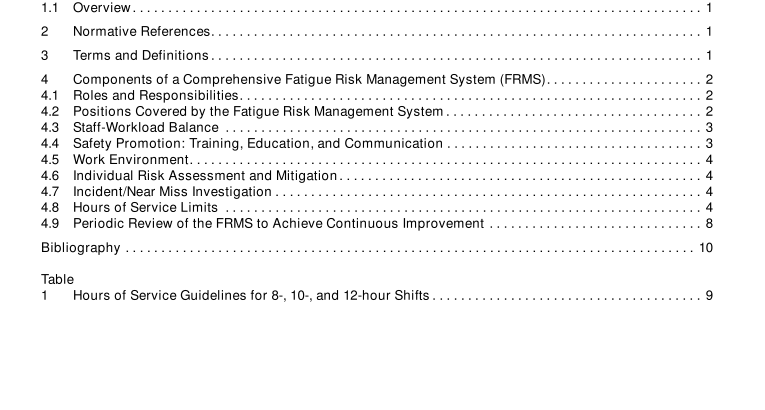API RP 755:2010 pdf free download.Fatigue Risk Management Systems for Personnel in the Refining and Petrochemical Industries
4.5 Work Environment A FRMS should take into account the type of work that is being done. Adequate opportunity for work breaks should be made available, based in part on the nature of the work. Heavy physical activity may be more fatiguing and require more breaks than lighter activities. Workers performing sedentary work that requires constant vigilance may need breaks to help prevent “automatic behaviors” (i.e. performing tasks without adequate conscious attention). Where possible, the work environment should be designed to enhance alertness. Work spaces should be brightly lit, utilizing indirect lighting to avoid glare and eye strain. Indoor temperature should be controlled at the lower end of the comfortable range. Humidity should also be controlled within a comfortable range. Workstations should be designed utilizing ergonomic principles to prevent musculoskeletal fatigue associated with repetitive strain.
4.6 Individual Risk Assessment and Mitigation Companies shall encourage individuals to be continuously aware of their level of fatigue and take appropriate steps to enhance their alertness while on duty. If and when they determine that they are too fatigued to work safely, they shall report this to their supervisor. Individuals should also be alert to evidence that others in the workplace may be fatigued and bring their concerns to their supervisor. In order to encourage this, a culture of fatigue management should be created in which workers are comfortable in disclosing their personal sleep or fatigue status, and seeking assistance is encouraged, consistent with the company protections afforded to reporting other safety concerns. Individuals working shift work and others who may be involved in working extended hours during plant outages should use their time off the job to get appropriate sleep and maintain their alertness and fitness for duty. Supervisors shall be alert to signs of excessive fatigue in employees and contractors.
They shall be given the responsibility and the authority to take appropriate steps to ensure employees are alert enough to safely perform their work. Individuals who experience repeated bouts of excessive fatigue should be referred to their health professional or medical department for further evaluation and advice regarding actions they can and should take to maximize their alertness. Because illness, stress and physical fitness impact fatigue, consideration should be given to implementing programs that are designed to encourage prevention and management of medical conditions, including sleep disorders, and promote psychological and physical fitness.
4.7 Incident/Near Miss Investigation The investigation of incidents should be conducted in a manner that facilitates the determination of the role, if any, of fatigue as a root cause or contributing cause to the incident. Information collected should include the time of the incident, the shift pattern, including the number of consecutive shifts worked, the number of hours awake, the number of hours of sleep in the past 24 hours by the individuals involved; the shift duration (and any overtime worked); whether the incident occured under normal operations or an extended shift; whether an outage was occurring; and, other fatigue factors. It should be noted that for individual incidents, often no definitive conclusion regarding the role of fatigue may be possible. However, aggregate analysis of incidents may reveal patterns suggestive of the role of fatigue that is not apparent by evaluating incidents individually.
4.8 Hours of Service Limits The FRMS shall specify hours of service limits that shall not exceed those in this section, taking into account the exception process in 4.8.5. These limits have been developed in the context of the existence of a comprehensive FRMS. Consistently working at the limits shown is not sustainable and may lead to chronic sleep debt. The overall FRMS shall be designed to prevent employees from frequently working at or near these limits over the long term. The objective of these limits is to establish the triggers at which additional fatigue risk evaluations will be performed in the short term.API RP 755 pdf download.API RP 755:2010 pdf free download
